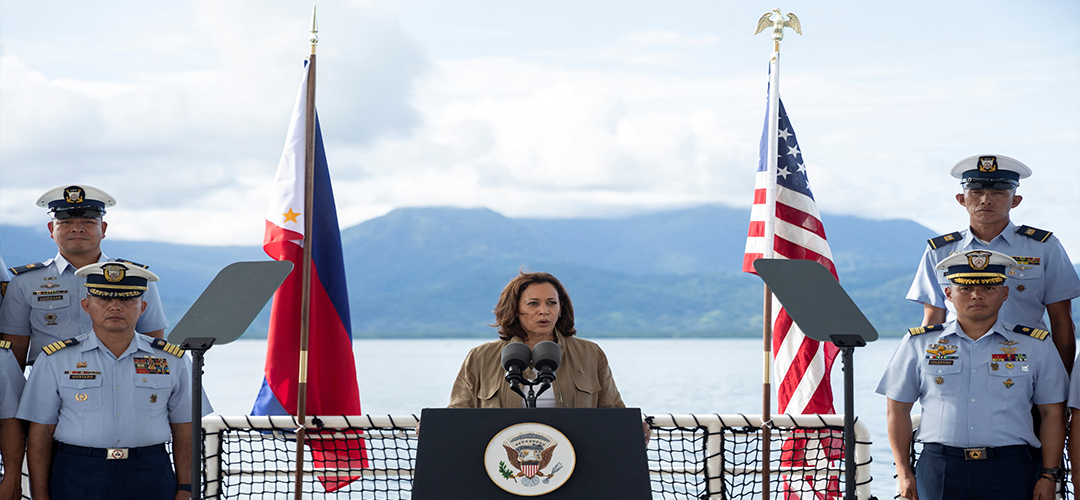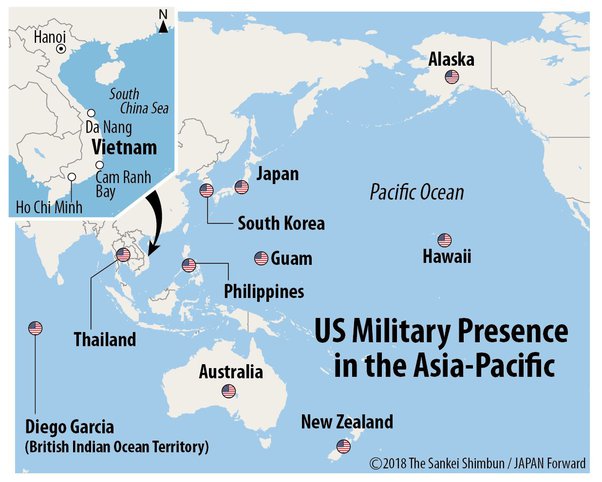US-PHILIPPINES: A NEW PHASE!
November 26, 2022 | Expert Insights

After a gap of nearly five years, a high-level American official visited the Philippines, a former colony and long-time ally in Southeast Asia. From World War II through Korea and later during the Vietnam war, the Philippines have been steadfast partners of the U.S. and militarily very close.
But this relationship quickly deteriorated soon after President Rodrigo Duterte came to power. As a corollary to his olive branch to China, with whom he advocated joint exploration of the oil reserves in the South China Sea and wanted to maintain an 'independent foreign policy', the US-Philippines relationship went South. When President Barak Obama called out President Duterte for his massive human rights violations in his anti-drug campaign, Duterte made personal attacks on the President in retaliation.
Hopefully, Vice President Kamala Harris will attempt to repair the damage and restore the relationship to an even keel. The fact that the new President, Marcos Jr, is from an established political family that has long enjoyed the patronage of the U.S. could help heal some of the scars. President Ferdinand Marcos Jr. has overseen a flurry of high-level interactions between the Philippines and the United States at an unparalleled pace in his first five months in office.
Background
The Philippines is strategically important to the U.S. because of its geographic location. The largest island, home to Manila, lies only 360 kilometres south of Taiwan and has the South China Sea to its west.
Whatever the political utterings between the two nations, the fact remains that a strong military partnership has been the bedrock of their mutual alliance. Even today, there is very close cooperation between the two nations' militaries. A 1951 Mutual Defence Treaty requires both sides to go to each other's aid in case of an external attack. Since 1998 there has been a Visiting Forces Agreement, and in 2014 an Enhanced Defence Cooperation Agreement was signed, allowing the U.S. military access to all the bases in the Philippines and creating logistics bases there. However, this is hardly surprising as the two largest military bases that the U.S. constructed anywhere in the world exist in the Philippines- the Clark Air Base and the Subic Bay Naval Base-which were in American control till the 1990s.

Analysis
In these times of escalating tensions and the game of brinkmanship being played by the U.S. and China, the visit of the U.S. Vice President is more of a signalling to China conveying the American determination to stand by its allies in the Indo-Pacific.
Disillusioned by American inability to stand by its allies in the South China Seas confrontation with China, under President Duterte, the Philippines had switched tracks from being a staunch ally of the U.S. to a more independent foreign policy proclaiming “friends to all and enemy to none”.
Six years back, in a landmark decision, the Permanent Court of Arbitration at The Hague had ruled that there was no evidence to prove that China enjoyed exclusive ownership of much of the South China Sea based on historical claims asserted by China. However, in his efforts to please the Dragon, who was pumping money into the Philippines, President Duterte is accused of squandering the opportunity.
When Duterte struck a deal with Beijing for joint exploration of oil and gas in the South China Sea, the move divided the country over the morality of supporting Chinese goals in an area rightfully theirs. However, due to constitutional issues and worries regarding Philippine sovereignty, the administration cancelled the agreements in June 2022.
While the dividends from the ‘olive branch’ approach to China have remained elusive, the pro-US lobby in the Philippines has been worrying about the deteriorating influence of Washington in the Philippines. More distressing is that the Philippines finds itself in a predicament trying to balance the interests of its former coloniser-turned-ally, the U.S. and its major trading partner, China. In the struggle for global hegemony, countries throughout the region are in a similar dilemma to choose a side.
A confrontation between the Chinese Coast Guard and the Philippine Navy on the eve of her tour to Palawan acted as a reminder of the heightened tensions in the West Philippine Sea.
Vice President Kamala Harris revealed at least 17 new bilateral projects in health, clean energy, high-tech industry, and the development of 5G networks to aid areas impacted by illegal fishing. She also disclosed that the Philippines would acquire financial and real-time intelligence assistance as part of the Quad's Indo-Pacific Maritime Domain Awareness initiative. These initiatives will build up on the existing Enhanced Defence Cooperation Agreement (EDCA) between the two nations, which permits U.S. forces to use designated places in the Philippines for joint military training and security drills.
Harris' trip to Palawan is no accident. The South China Sea, located just off its west coast, has become a source of tension in the region since Beijing asserted its ownership of almost the whole territory and the surrounding islands by citing old cartography. The Philippines, Vietnam, Malaysia, and Taiwan have also claimed overlapping marine territory, joining China as claimants.
During her visit, several Filipinos took to the streets to protest against what they call “becoming the next puppet in the power game”. Additionally, the island is home to fishing villages whose way of life has been harmed by foreign ship fleets that have clogged Philippine waterways and their livelihoods.
Assessment
- At the very least, the Vice President's visit aims to reinforce the idea that the U.S. is more committed than ever to resetting relations with the Philippines. This visit is a statement of intent to China in the wake of Ms Nancy Pelosi's explosive visit to Taiwan.
- The Philippines cannot expect to remain neutral if the face-off in Taiwan Straits turns violent. Its world-class naval and air facilities and stocks of American war materials are invaluable for any large-scale U.S. military commitment in the region. The island nation will be invariably dragged into a conflict between the two powers, whether it likes it or not. Therefore, there is no sense in antagonising the U.S. to please China, a not-so-reliable partner, either.
- President Marcos Jr is treading dangerous waters as he changes the tack from his predecessor. The U.S. is a distant ally. China is just next door, sitting on numerous natural and man-made islands scattered over the choke points in the disputed South China Sea, ready to strangle Filipino trade and commerce.








Comments